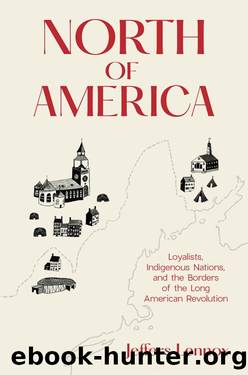North of America by Jeffers Lennox

Author:Jeffers Lennox [Lennox, Jeffers]
Language: eng
Format: epub
ISBN: 9780300226126
Publisher: Yale University Press
Published: 2022-08-29T16:00:00+00:00
Jedidiah Morse, A New Map of Upper and Lower Canada, 1794. Geographers such as Morse kept United States citizens informed of political and geographic developments in the British provinces. Lionel Pincus and Princess Firyal Map Division, The New York Public Library Digital Collections.
And so a second plan was hatched. This one fit more explicitly into the American narrative that Indigenous warriors and their chiefs were supported and encouraged by the government in Canada, but it relied on the hope that American officials could be persuaded to seek British mediation in their conflict with the Indigenous nations. The crux of this plan was to encourage the Iroquois, Miami, Shawnee, and other nations to demand of American officials that the British participate in settling their differences with the United States. The request must appear âspontaneous,â but Hammond encouraged Lieutenant Governor Simcoe to do everything in his power to promote it.67 This scheme also had problems: the British would never actually support open hostilities against the Americans, and it created the danger that the Americans and the western Indigenous nations might reach a peace without British participation. As Hammond informed Simcoe, American officials knew they could not afford another loss like those of 1790 and â91. They might be prepared for war, but Congress increasingly hoped to negotiate a peace.68 Rather than provide their Indigenous allies with ammunition for their guns, British officials would supply evidence for their arguments. Simcoe suggested to Alexander McKee that the western nations receive copies of the treaties and deeds they had signed with Britain before American independence. These documents, which American officials would never supply if requested, might support Indigenous territorial claims.69
Congressâs own tactics, meanwhile, focused on the promise of diplomacy backed by the threat of military intervention. American officials, Washington and Knox included, understood that destroying Indigenous nations could sully the United Statesâ international standing and paint Congress as just another imperial force incapable of making alliances with its neighbors.70 Administrators thus hoped treaty negotiations would succeed, or at least demonstrate a good-faith attempt at diplomacy, while buying time for military preparations. Convincing the western nations that the United States government believed in peaceful negotiations required just the right messengers. Over the spring and early summer of 1792, Washington and Knox invited Iroquois chiefs to Philadelphia under the premise of discussing a âcivilization plan.â The idea had originated with Timothy Pickering, who had experience with Indigenous nations and sympathized with their plight at the hands of unscrupulous settlers. Unbeknownst to Pickering, Washington and Knox had a separate goal: to use the Iroquois to mediate a peace with the western confederacy. It took several weeks of careful diplomacy to broach the subject, but eventually Pickering succeeding in convincing several Iroquois delegates, including the Seneca war chief Gyantwachia, or Cornplanter, to undertake the mission.71 Joseph Brant agreed to serve on the mission even though he had refused the initial invitation to Philadelphia; he traveled to the capital only after receiving a separate invitation.72 Citizens in Philadelphia and beyond
Download
This site does not store any files on its server. We only index and link to content provided by other sites. Please contact the content providers to delete copyright contents if any and email us, we'll remove relevant links or contents immediately.
| 19th Century | 20th Century |
| Exploration | First Nations |
| Founding | Pre-Confederation |
| Province & Local | War of 1812 |
Cat's cradle by Kurt Vonnegut(15152)
Pimp by Iceberg Slim(14318)
4 3 2 1: A Novel by Paul Auster(12263)
Underground: A Human History of the Worlds Beneath Our Feet by Will Hunt(11997)
The Radium Girls by Kate Moore(11899)
Wiseguy by Nicholas Pileggi(5647)
Perfect Rhythm by Jae(5305)
American History Stories, Volume III (Yesterday's Classics) by Pratt Mara L(5239)
The Fire Next Time by James Baldwin(5224)
Paper Towns by Green John(5065)
Pale Blue Dot by Carl Sagan(4886)
A Higher Loyalty: Truth, Lies, and Leadership by James Comey(4822)
The Mayflower and the Pilgrims' New World by Nathaniel Philbrick(4403)
The Doomsday Machine by Daniel Ellsberg(4397)
Killers of the Flower Moon: The Osage Murders and the Birth of the FBI by David Grann(4368)
The Sympathizer by Viet Thanh Nguyen(4287)
Too Much and Not the Mood by Durga Chew-Bose(4255)
The Borden Murders by Sarah Miller(4216)
Sticky Fingers by Joe Hagan(4086)
